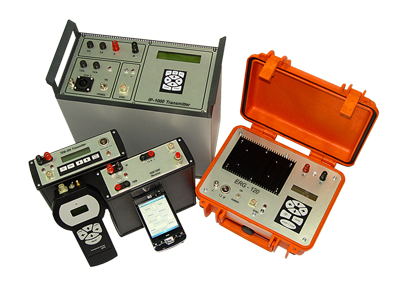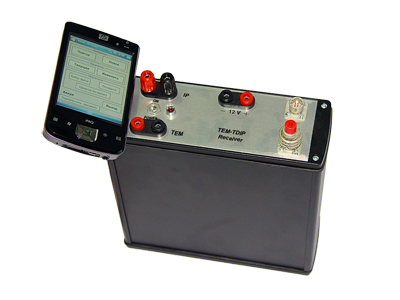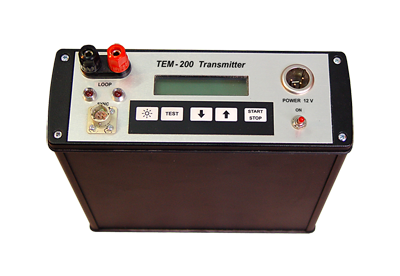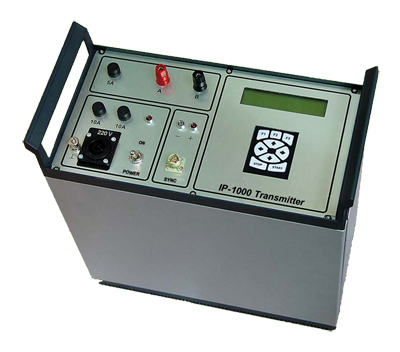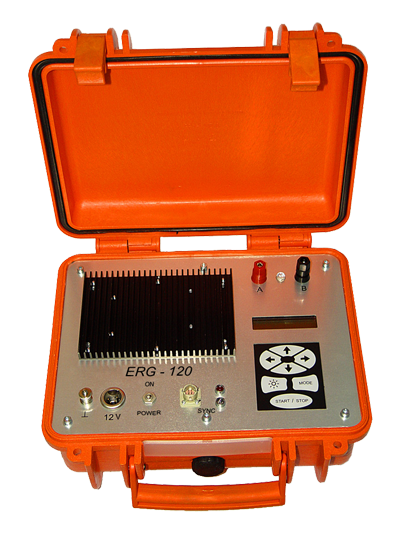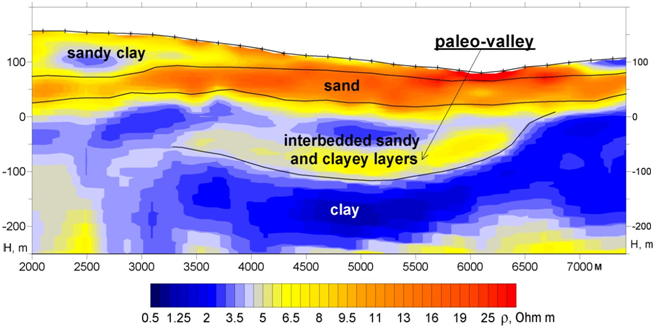AIE-2 instruments
AIE-2 TEM-TDIP measuring system has been developed and produced by ELGEO Research & Production Company, St-Petersburg, Russia.
The main area of activity of ELGEO is the design and manufacture of TDIP and TEM instrumentation, development of geophysical software and conducting of field geophysical surveys.
TEM/TDIP MEASURING SYSTEM
Transient Electromagnetic (TEM) and Time Domain Induced Polarization (TDIP) methods are very effective geophysical tools for exploration of ore or hydrocarbon deposits as well as for hydrogeological, environmental and civil engineering investigations.
Transient Electromagnetic method is based on the pulse inductive excitement and measurement of electromagnetic field. An ungrounded transmitter loop which energised by rectangular pulses of strong current is used as a source of the primary magnetic field. Decaying secondary field caused by induced vortex currents in the ground is detected with receiver loop, usually coincident, or with the same transmitter loop. The last configuration is called “one loop array”. Transient decay rate depends on size and conductivity of ground structures, so TEM is most effective in exploration for well conductive massive ore bodies.
The Time-Domain Induced Polarization method investigates spatial and temporal variation of the secondary electric field in the ground that is caused by rectangular pulses of the primary galvanic current caused to pass through a pair of grounded points. Well polarizable ore minerals are the main targets for IP method.
Being quite different in main physical principles both methods are based on pulse excitation of the primary electromagnetic field, so they could be joined within a unified pulse electrical prospecting system. Besides, combination of TEM and TDIP methods being applied to one site could substantially improve amount and quality of geophysical information. Such a system has been developed by Elgeo Ltd.
AIE-2 measuring system allow to perform a complete cycle of TEM or TDIP works, starting with gathering of primary field data and finishing with data interpretation and presentation of the results. AIE-2 system involves a number of interconnected components: instrumentation for excitement and registration of electromagnetic and polarization transients and software products.
AIE-2 system comprises:
• TEM/TDIP receiver
• TEM-200 transmitter
• IP-1000 transmitter
• ERG-120 transmitter
• GPS synchronizers
• TEM&IP software for data preprocessing, visualization and interpretation
TEM/TDIP receiver is intended for registration of transient voltage in TEM and TDIP methods. For TEM measurements it is connected to a receiver loop or to a multi-turn coil. In IP mode the signal is taken from a grounded receiver line with nonpolarizable electrodes. The receiver is based on 16-bit ADC and an Analog Devices signal processor, that provide with noise-immune analog-digital conversion of input voltage and real-time signal preprocessing.
• Maximum input voltage: ±10 V
• Time ranges: TEM: 5 us – 10 s; IP: 30 ms – 50 s
• Compensation of constant input signal IP: ± 2.5 V
• Receiver-transmitter synchronization: TEM: GPS or cable; IP: GPS, cable or autonomous
• Operating time without battery recharging: not less than 8 h
• Power supply (internal battery) : 12 V
• Weight (without minicomputer): 3.0 kg
All the functions of TEM/IP receiver are controlled by a minicomputer (standard component of the receiver) or by a notebook computer via Bluetooth or RS-232 interface. Operating program for the signal processor is loaded from the control computer, the measured data are sent back and saved in the computer memory. Receiver control program provides with setting optimal measuring parameters, graphic presentation of measuring results to assess their quality and saving the data. Operational testing of the system in different field conditions, including extreme ones, proved its high reliability. That was achieved owing much to using of up-to-date electronic components as well as firm, dust- and water-protective instrumentation cases.
TEM-200 transmitter generates periodic bipolar rectangular current pulses with pauses (50 % duty
cycle) in an inductive load (loop) as a source of primary magnetic field in TEM method. It can be loaded on a loop with a size up to 400×400 m.
• Maximum output power: 200 W
• Output current range: 0.5-10 A
• Current ramp time: 10 us at 100×100 loop
• Power supply: 12 V (external battery)
• Receiver-transmitter synchronization: GPS or cable
• Weight (without battery): 2.5 kg
IP-1000 transmitter is intended for exploration with IP or resistivity methods. IP-1000 generates rectangular current pulses in grounded line for gradient survey or sounding. It can be used both in time-domain mode (bipolar rectangular current with 50 % duty cycle) or frequency-domain (square wave).
• Maximum output power: 1000 W
• Maximum output voltage: 800 V
• Output current range: 0.01-2 A
• Current pulses duration/frequencies: 1 to 64 s (TD); 0.08 to 4.88 (FD)
• Power supply: 220 V at 50 Hz (motor generator)
• Receiver-transmitter synchronization: GPS, cable or autonomous
• Weight (without battery): 10 kg
ERG-120 is a portable transmitter intended for generating rectangular current pulses in grounded line for exploration with IP or resistivity methods. ERG-120 can be used both in time-domain mode (bipolar rectangular current with 50 % duty cycle) or frequency-domain (square wave).
• Maximum output power: 120 W
• Maximum output voltage: 600 V
• Output current range: 5-400 mA
• Current pulse durations/frequencies: 1 to 64 s (TD); 0.08 to 4.88 (FD)
• Power supply: 12 V (external battery)
• Receiver-transmitter synchronization: GPS, cable or autonomous
• Weight (without battery): 3.5 kg
Case Histories: Exploration of buried paleo-valleys
AIE-2 system can be effectively used for exploration of buried structures within sedimentary basins which are often associated with a variety of mineral deposits or water. TEM survey with one-loop
configuration was fulfilled to map some paleo-valleys in Kalmykiya Republic (Jointly with “Kolcovgeologiya” Ltd., Essentuki, Russia). They were buried in a considerable depth of up to 300 m.
Concave structures can be clearly seen in the TEM resistivity cross-sections.
These structures correspond to paleo-valleys build up with a series of interbedded clayey and sandy layers plunged into highly conductive clayey sediments. They are covered with quite a thick clayey quaternary overburden.
Despite quite high level of industrial EM noise a required depth of penetration was achieved owing to effective noise suppression methods applied in the AIE-2 system.
